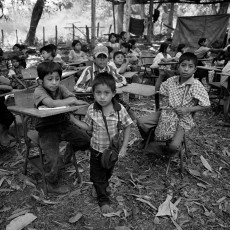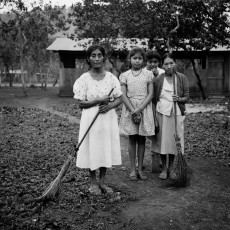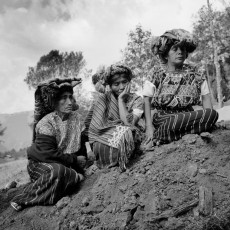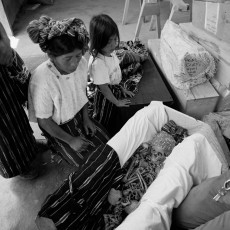
One night in 1980, soldiers came to Domingo’s house and dragged away his older brother and sister. They were never seen again. Communities of Population in Resistance of the Sierra, 1993

Ana holds an exploded mortar shell that the army fired at her community during an offensive in 1989. Communities of Population in Resistance (CPR) of the Sierra, 1993

The crosses on the side wall of this church bear the names of those killed or disappeared in San Juan Cotzal. 1993

Today is Monday, November 15th, 1993. We must have good food in order to grow, so that our family is healthy. The CPR of the Sierra produces its own food. It is essential that all workers unite to struggle for our rights as indigenous people and as Guatemalans. That’s why the CPR struggles…. CPR of the Sierra, 1993

In the late morning Maria makes fresh corn tortillas. Cabá, CPR of the Sierra, 1993

Juan and María’s wedding. Tzucuna, Cabá, CPR of the Sierra, 1993

Nicolás, a Mayan priest, holds a cross that lists the ages of his seven massacred relatives. CPR of the Sierra, 1993

A community health promoter examines an infant in the clinic. Communities of Population in Resistance of the Sierra, 1993

Susana, Hugo and Juanito were all born in hiding in the jungle. Communities of Population in Resistance (CPR) of the Ixcán, 1994

Daniel returns from working one of the small, hidden plots of corn near his settlement. Popular Communities in Resistance (CPR) of the Petén, 1995

Albeño settlement, Popular Communities in Resistance of the Petén, 1995

Popular Communities in Resistance (CPR) of the Petén, 1995

“Peace Accords to Be Signed Today.” Guatemala City, December 29, 1996

The first full day of classes in the new resettlement community of Tesorito Nueva Esperanza, one of eight new resettlement communities for the CPR of the Sierra. Patulul, 2000

Juliana checks her son’s hair for lice. Some three hundred families of the CPR of the Ixcán resettled here after they left their hiding places in the jungle in late 1996. Primavera del Ixcán, 2000

Primavera del Ixcán, Quiché, 2000

These women and others sweep the community every two weeks. Ninety-two families of the Popular Communities in Resistance of the Petén left their jungle hiding place and moved to these lands in late 1998. Salvador Fajardo community, Petén, 2001

Two sisters watch as the remains of their mother and four small siblings are exhumed. The sisters were present that day in August of 1982 when soldiers shot their loved ones, but they managed to escape. Nebaj, 2000

Clara holds a photograph of her husband whose remains are being unearthed. He was fifty years old when soldiers shot him in 1982. Nebaj, 2000

Three women watch as the remains of relatives and friends who were killed in the early 1980s are exhumed. Nebaj, 2000

Nebaj, Quiché, 2000

The trajectory of a bullet through the skull. These remains were exhumed from the grounds of a convent in Joyabaj which was occupied by the Guatemalan army in the 1980s and used as a garrison, torture center, and clandestine cemetery. Santa Cruz del Quiché, 2000

A few days before the reburial, the remains are returned to the families. With love and respect, they prepare the remains of their loved ones for the mass, wake, and re-burial. Nebaj, 2001

Coffins containing the remains of victims of massacres from the 1980s wait to be carried to the church in Nebaj for the memorial mass. Quiché, 2001

Family members and villagers prepare to bury the remains of fifteen people in the community cemetery of the village of Janlay. Nebaj, 2001